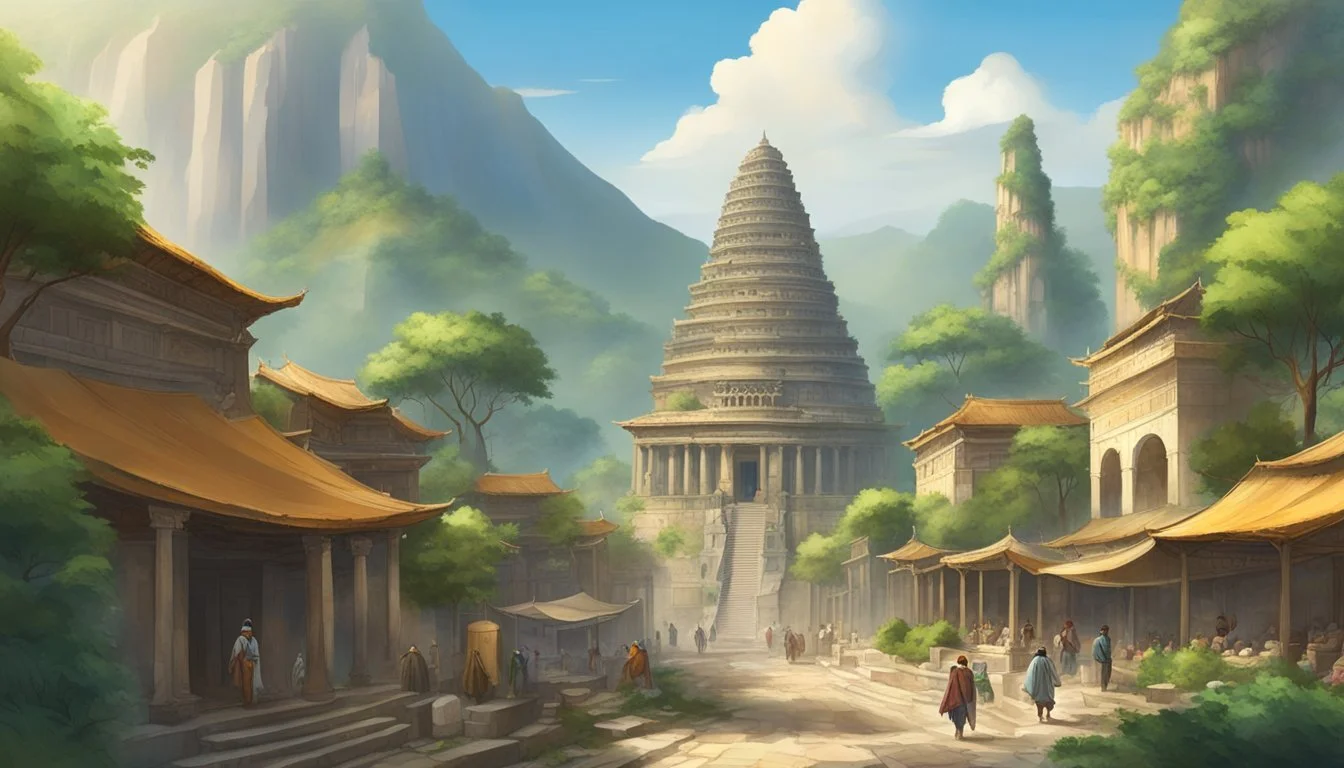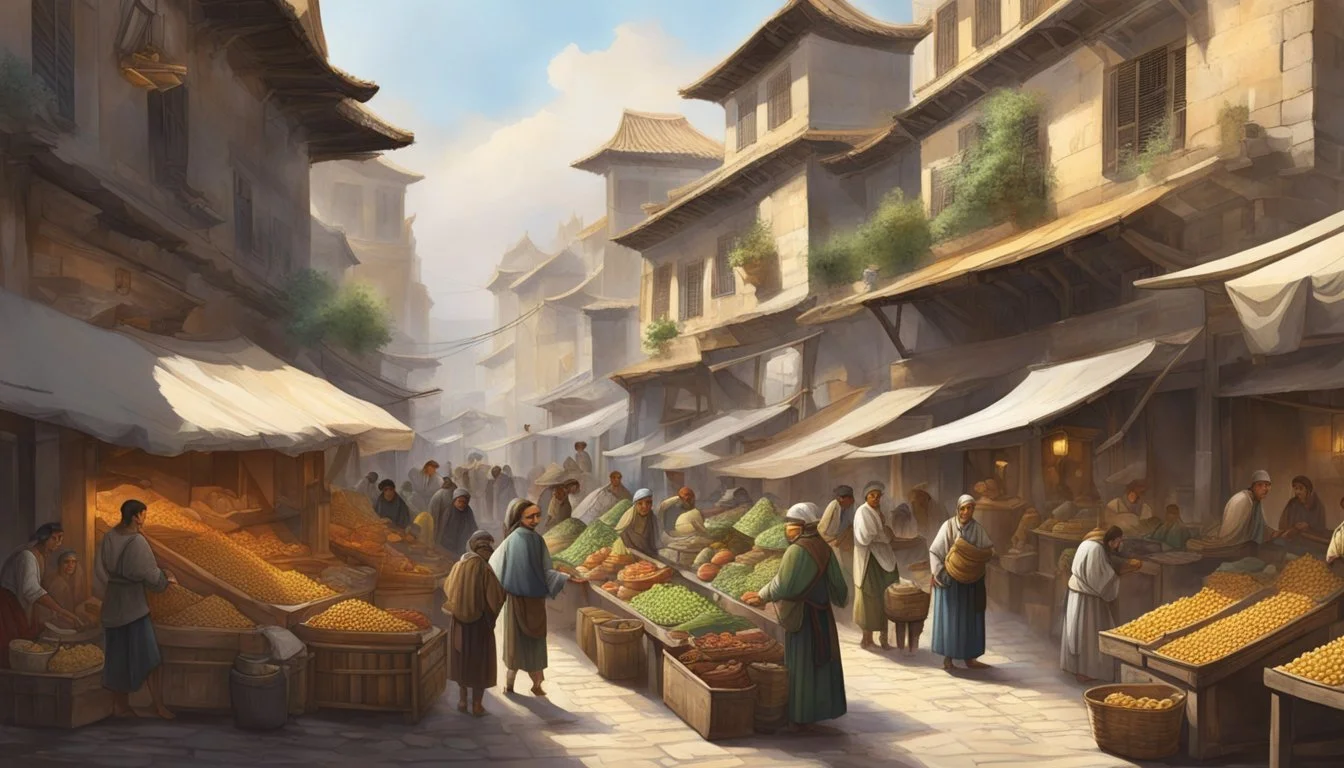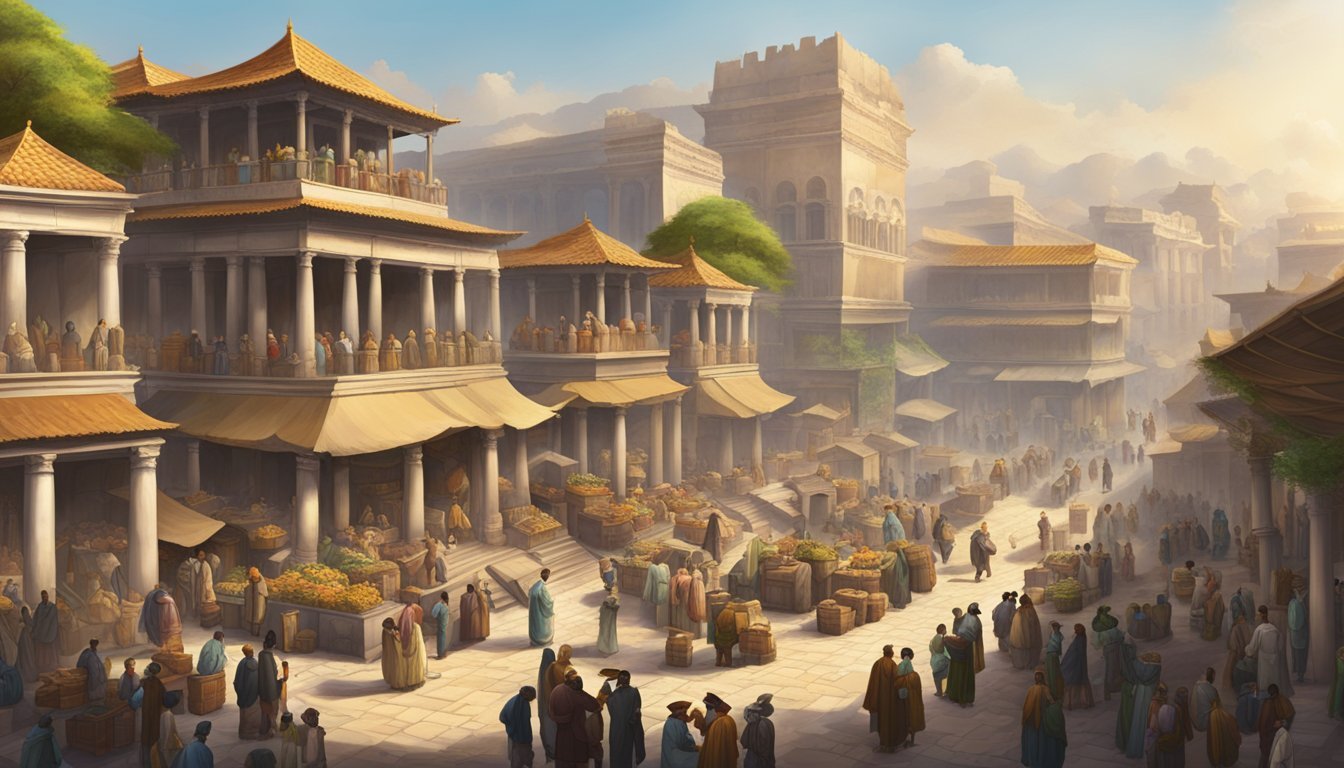The Art Direction of 'Testament': Creating an Authentic Ancient World
Crafting Biblical Realism on Screen
The art direction of 'Testament' brings the ancient world to life with painstaking attention to detail and historical accuracy. Drawing inspiration from archaeological findings, historical texts, and extensive research, the production design team crafted a visually stunning backdrop for this biblical epic.
From the intricate costumes to the meticulously designed sets, every element in 'Testament' was carefully chosen to immerse viewers in the time and place of the New Testament. The art directors consulted with historians and biblical scholars to ensure authenticity in everything from architecture to daily objects used by characters.
Colors, textures, and materials were selected to reflect the harsh realities of life in the ancient Mediterranean. Weathered stone structures, sun-baked earth tones, and rough-hewn fabrics create a tangible sense of the past. This commitment to realism extends to the smallest details, including historically accurate writing materials, cooking utensils, and religious artifacts that populate the world of 'Testament'.
Historical Context and Inspiration
The art direction of 'Testament' draws from key historical elements of the Roman Empire and early Christianity. These influences shaped the visual landscape and cultural backdrop of the film's ancient world setting.
Influence of the Roman Empire
The Roman Empire's architecture and aesthetics heavily influenced the film's art direction. Grand structures like the Colosseum and Pantheon inspired set designs. Roman roads, aqueducts, and military camps were meticulously recreated to capture the empire's engineering prowess.
Costume designs incorporated elements of Roman military uniforms and civilian togas. Attention to detail extended to hairstyles, jewelry, and everyday objects like pottery and furniture.
The film's depiction of urban life drew from archaeological evidence of ancient Roman cities. Market scenes bustled with authentic-looking goods and trade practices of the era.
Christianity in the Ancient World
Early Christian symbols and practices were woven into the film's visual narrative. Subtle fish symbols and secret meeting places reflected the faith's underground origins.
Art directors researched early Christian art found in catacombs and house churches. These influenced the film's depiction of worship spaces and religious iconography.
The contrast between pagan Roman religious practices and emerging Christian rituals was visually emphasized. This juxtaposition highlighted the cultural tensions of the time.
Constantine and the Spread of Christianity
Constantine's pivotal role in Christianity's rise shaped key visual elements. The film portrayed his vision of the Chi-Rho symbol and its subsequent use on military standards.
The Edict of Milan's impact was shown through changes in public spaces and the gradual emergence of Christian architecture. The transformation of pagan temples into churches was a central visual theme.
Constantinople's founding as a new Christian capital influenced the film's depiction of urban development. Byzantine artistic styles began to emerge, foreshadowing the empire's future aesthetic direction.
Artistic Foundations
The art direction of 'Testament' drew inspiration from early Christian artistic traditions, iconography, and architecture. These elements formed the basis for creating an authentic visual representation of the ancient world depicted in the film.
Early Christian Art
Early Christian art emerged in the 2nd and 3rd centuries CE. It blended Greco-Roman artistic styles with new Christian themes and symbolism. Catacomb paintings and sarcophagi carvings featured biblical scenes and allegorical figures.
The Good Shepherd motif became a popular representation of Christ. Artists depicted him as a beardless youth carrying a lamb on his shoulders. Fish symbols, known as ichthys, were used as secret signs among Christians.
Frescoes in Roman catacombs showcased biblical narratives and Christian symbols. These underground burial chambers served as early worship spaces and artistic canvases.
Iconography of Christianity
Christian iconography developed a rich visual language to convey religious concepts. The cross became the central symbol of Christianity, representing Christ's sacrifice and redemption.
Nimbus halos adorned the heads of holy figures, signifying their divine status. Artists used specific attributes to identify saints, such as keys for St. Peter or a wheel for St. Catherine.
The Virgin Mary was often depicted holding the infant Jesus, known as the Madonna and Child. This image became a cornerstone of Christian art throughout history.
Scenes from Christ's life, including the Nativity, Crucifixion, and Resurrection, formed key elements of Christian iconography. These narratives were frequently depicted in church decorations and illuminated manuscripts.
Architecture of Worship
Early Christian architecture adapted Roman building types to suit new religious needs. The basilica, originally a secular Roman structure, became the primary model for Christian churches.
Basilicas featured a long central nave flanked by side aisles. The apse, a semicircular recess at the east end, housed the altar and clergy. This layout allowed for large congregations and processional rituals.
Centrally-planned churches, such as martyria and baptisteries, used circular or polygonal designs. These structures often featured domed roofs, symbolizing the heavenly realm.
Mosaic programs adorned church interiors, covering walls and ceilings with vibrant biblical scenes and symbolic imagery. The glittering surfaces created an otherworldly atmosphere for worship.
Narrative and Symbolism
The art direction of 'Testament' draws heavily from biblical narratives and Christian symbolism to create an authentic ancient world. Carefully chosen imagery and visual motifs bring key stories and themes to life on screen.
Biblical Stories and Characters
'Testament' faithfully depicts many iconic Bible stories. The nativity scene showcases Mary, Joseph, and baby Jesus in a humble manger setting. Adam and Eve's temptation in Eden uses lush garden imagery. David's triumph over Goliath is portrayed through dynamic action.
Key biblical figures are represented with historical accuracy. Jesus is shown teaching and performing miracles. The apostles appear in scenes like the Last Supper. Moses parts the Red Sea in a dramatic effects sequence.
The art direction also includes lesser-known Bible characters to add depth and authenticity to the ancient world.
Themes of Christian Faith
Visual symbolism reinforces core Christian themes throughout 'Testament'. Light and darkness motifs represent good versus evil. Water imagery signifies purification and rebirth.
The cross appears as a recurring symbol, foreshadowing Jesus' crucifixion. Pastoral scenes with shepherds and sheep evoke the Good Shepherd parable. Fish symbols subtly reference early Christian iconography.
Angelic figures in white robes manifest at pivotal moments. Devils and demons embody temptation. The art direction uses these visual cues to convey complex theological concepts.
Eucharistic Imagery and References
'Testament' incorporates subtle Eucharistic symbolism into many scenes. Bread and wine feature prominently, especially during the Last Supper sequence. A golden chalice represents the Holy Grail.
Wheat fields and grapevines appear in background scenery as references to the body and blood of Christ. Scenes of breaking bread carry deeper meaning beyond just eating.
The art direction includes visual nods to famous Eucharist-themed paintings like Caravaggio's works. These artistic touches enrich the film's spiritual atmosphere and historical authenticity.
Depicting the Divine
Portraying divine figures and events in 'Testament' required careful attention to historical accuracy and artistic interpretation. The production team drew inspiration from early Christian art and ancient traditions to create authentic representations.
Portrayal of the Crucifixion
The crucifixion scene in 'Testament' adhered to historical records and archaeological evidence. Roman crucifixion methods were meticulously researched to ensure accuracy.
The set design incorporated a T-shaped cross, reflecting scholarly theories about the actual shape used. Jesus' position on the cross was based on skeletal remains of crucifixion victims from the period.
Lighting played a crucial role in conveying the somber atmosphere. Darkened skies and dramatic shadows were used to reflect biblical accounts of the event.
Renditions of the Nativity and the Last Supper
The nativity scene blended elements from early Christian art with historical realism. The stable was depicted as a cave, drawing from traditions in the Eastern Church.
Mary and Joseph were portrayed in simple, period-appropriate clothing. The manger was crafted from stone, based on archaeological findings from the region.
For the Last Supper, the art department created a low table with cushions for seating, reflecting dining customs of the time. The meal included historically accurate foods like bread, fish, and wine.
Evolution of the Image of Christ
'Testament' depicted Christ's appearance differently throughout the narrative, reflecting changing artistic traditions over time.
In early scenes, Jesus was portrayed with short hair and clean-shaven, based on early Christian catacomb art. This contrasted with later depictions showing him with long hair and a beard.
The costume design evolved subtly, from simple tunics in early scenes to more elaborate robes in later ones. This shift mirrored the development of Christ's image in Byzantine and medieval art.
Notable Art from 'Testament'
'Testament' showcases a rich array of visual artworks that bring the ancient world to life. From intricate mosaics to grand frescoes, the production's art team meticulously crafted pieces that reflect historical accuracy and artistic vision.
Significant Pieces and Artists
The series features stunning recreations of early Christian art. A centerpiece is the apse mosaic depicting Christ Pantocrator, reminiscent of those found in Byzantine churches. This imposing figure, with piercing eyes and a golden halo, dominates the scenery.
Another notable work is a fresco cycle illustrating Old Testament stories. Painted in the style of late Roman catacomb art, it uses earthy tones and simplified forms to convey biblical narratives.
The production also highlights the talent of fictional artist Marcus, whose sculptures blend Greco-Roman techniques with emerging Christian themes.
Visual Storytelling Techniques
'Testament' employs various visual techniques to enhance its narrative. Iconography plays a crucial role, with symbols like the chi-rho and fish appearing subtly throughout the sets.
The use of color is particularly effective. Scenes set in Roman spaces feature vibrant reds and golds, while early Christian gatherings are depicted in muted earth tones, reflecting their clandestine nature.
Lighting design complements the artwork, creating dramatic shadows in catacomb scenes and ethereal glows around religious figures.
Revival of Ancient Styles
The art direction of 'Testament' expertly revives ancient artistic styles. Mosaic programs, a hallmark of Byzantine art, are meticulously recreated with thousands of individual tesserae.
Frescoes mimic the Pompeian style, with trompe l'oeil effects creating the illusion of depth. These works often incorporate biblical scenes alongside secular Roman motifs, illustrating the cultural fusion of the era.
The series also showcases early Christian manuscript illumination, with ornate initials and miniature scenes adorning prop texts. These pieces reflect the emerging tradition of book arts in the late Roman world.
Art Direction Challenges
Creating an authentic ancient world for "Testament" presented numerous obstacles. The production team faced complex decisions balancing historical accuracy with modern storytelling needs. Extensive research and expert consultation played a crucial role in overcoming these challenges.
Achieving Authenticity
Recreating the visual landscape of early Christian art demanded meticulous attention to detail. Set designers studied archaeological findings to accurately depict architectural styles and living spaces. Costume designers researched ancient textiles and clothing patterns to craft period-appropriate wardrobes. Props teams sourced or fabricated items that matched historical records.
Lighting posed a unique challenge. Cinematographers had to simulate natural light sources like oil lamps and sunlight filtering through period-appropriate windows. This required innovative techniques to maintain historical accuracy while meeting modern filming standards.
The art department faced the task of reproducing early Christian symbols and motifs. They carefully studied surviving frescoes, mosaics, and manuscripts to incorporate authentic iconography into set designs and props.
Modern Interpretation vs Historical Accuracy
Balancing modern storytelling needs with historical authenticity created tension in the art direction process. The team had to make decisions about which elements to portray with strict accuracy and where to allow creative interpretation.
Color palettes presented a particular challenge. While historical accuracy might call for muted earth tones, the need for visual appeal on modern screens sometimes necessitated bolder choices. The art department developed a compromise palette that evoked the ancient world while remaining visually engaging.
Depicting Christian themes required careful consideration. The team aimed to represent early Christian beliefs authentically without alienating modern audiences of diverse backgrounds. This involved subtle visual storytelling through set design and props rather than overt religious imagery.
The Role of Research and Expertise
Extensive research underpinned every aspect of the art direction. The production team consulted historians, archaeologists, and art experts specializing in the early Christian period and Byzantine Empire. These collaborations ensured accuracy in details ranging from architectural styles to clothing fabrics.
Primary sources played a crucial role. The art department studied ancient texts, surviving artworks, and archaeological reports to inform their designs. They created detailed reference guides for each set, prop, and costume to maintain consistency throughout production.
On-set historical advisors provided real-time guidance during filming. These experts helped catch anachronisms and offered suggestions for more authentic alternatives. Their input was particularly valuable in scenes depicting religious rituals or daily life in the ancient world.
Legacy and Impact
The art direction of 'Testament' has left a lasting impression on Christian art, education, and cultural understanding. Its meticulous attention to historical accuracy and visual storytelling has resonated with audiences and scholars alike.
Influence on Contemporary Christian Art
'Testament' has inspired a resurgence of interest in early Christian art styles. Many modern artists have begun incorporating Byzantine-inspired elements into their religious works. The film's use of mosaics and frescoes has sparked a revival of these techniques in church decorations.
Some contemporary painters have adopted 'Testament's' muted color palette and naturalistic figure depictions in their portrayals of biblical scenes. The film's approach to representing spiritual concepts through visual metaphors has also influenced Christian graphic designers and illustrators.
Educational Value and Cultural Significance
'Testament' has become a valuable educational tool for art history and religious studies courses. Universities use scenes from the film to illustrate early Christian artistic conventions and symbolism. Museums have created exhibits pairing artifacts with corresponding imagery from the film.
The film has increased public awareness of the Byzantine Empire's cultural contributions. It has sparked renewed interest in visiting historical Christian sites and studying early church history. 'Testament' has also fostered interfaith dialogue by highlighting shared artistic traditions among different religious groups.
Testament's Place in Art History
Art historians consider 'Testament' a landmark in the accurate cinematic portrayal of early Christian aesthetics. The film's production design has set a new standard for historical authenticity in period dramas. Its meticulous recreations of lost artworks have provided valuable visual references for scholars.
'Testament' has revitalized academic interest in studying the evolution of Christian iconography. The film's innovative use of lighting to evoke spiritual themes has influenced cinematographers in both religious and secular productions. Its success has encouraged more filmmakers to explore ancient art styles as inspiration for their visual narratives.








